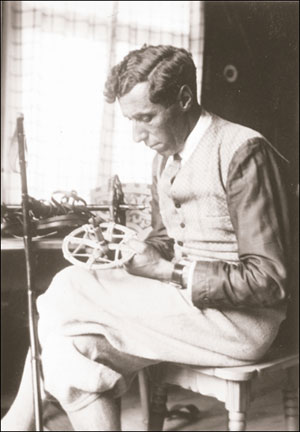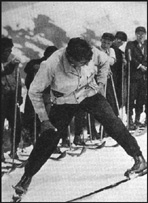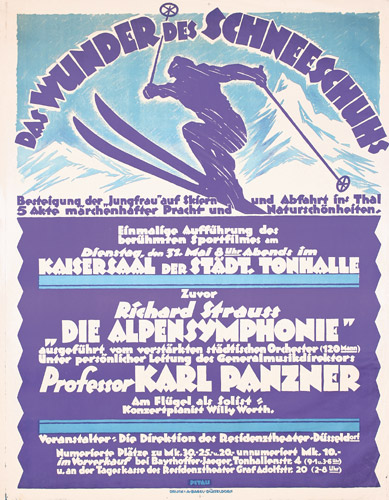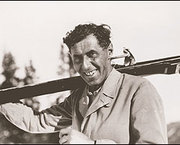
Hannes Schneider considerado por muchos como el padre del esquí moderno, fue el pionero del esquí alpino. Nacido en Austria en 1.890, hijo de un fabricante de queso, trabajo con su padre como aprendiz desde niño, pero la fuerza de la montaña y la nieve gano la partida, amó el esquí y amó el enseñar a esquiar a los demás.

El primer método unificado de la enseñanza del esquí. Dicho método domino durante años la enseñanza del esquí en el mundo. Básicamente consistía en pasar del paralelo a la cuña para hacer el giro e inmediatamente pasar de nuevo al paralelo para trazar la diagonal.
 Durante la Primera Guerra Mundial, Hannes se alisto en el ejercito austriaco como instructor de esquí, y en pocas semanas conseguía que los principiantes de las tropas austriacas se convirtieran en esquiadores competentes, también luchó en los frentes ruso e italiano.
Acabada la guerra volvió a St. Antón, donde continuó desarrollando sus técnicas de enseñanza del esquí e introdujo alguno de los conceptos de disciplina aprendidos en el ejército. Durante este nuevo periodo muchos de sus alumnos se dedicaron también a la enseñanza, poniendo especial énfasis en el concepto de la seguridad en la práctica del esquí.
Durante la Primera Guerra Mundial, Hannes se alisto en el ejercito austriaco como instructor de esquí, y en pocas semanas conseguía que los principiantes de las tropas austriacas se convirtieran en esquiadores competentes, también luchó en los frentes ruso e italiano.
Acabada la guerra volvió a St. Antón, donde continuó desarrollando sus técnicas de enseñanza del esquí e introdujo alguno de los conceptos de disciplina aprendidos en el ejército. Durante este nuevo periodo muchos de sus alumnos se dedicaron también a la enseñanza, poniendo especial énfasis en el concepto de la seguridad en la práctica del esquí.
Este desarrollo en los métodos trajo consigo un mayor control en los descensos y por tanto la posibilidad de bajar por sitios más inclinados y escarpados, paralelamente el esquí se empezó a contemplar como un deporte de riesgo.
En 1921, Arnold Franck, director alemán de documentales, rodó la primera película sobre la enseñanza del esquí de la historia. Esta película estaba basada en método Alberbg, siendo Hannes Schneider el encargado de las demostraciones, Des Schneeschuhs de Wunder.

Posteriormente y usando fotogramas de dicha película publicaron un libro con el mismo nombre que en 1.931 fue traducido al Ingles con enorme éxito.
En 1928, Hannes y Arnold Lunn organizaron la primera competición internacional “Open Arlberg-Kandahar”. La competición se celebro en St. Antón y la gano un esquiador austriaco.
Hannes visitó los Estados Unidos en 1936 para demostrar sus técnicas de esquí durante una exposición de deportes de invierno en el “Boston Garden”, realizo unas bajadas en una rampa de madera cubierta de hielo, preparada para la ocasión, dos semanas después repetiría dichas demostraciones en el “Madison Square Garden”.

Cuando Hannes volvió a casa después de su visita a EEUU, Hitler había empezado sus movimientos, Hannes fue encarcelado durante 18 meses, por haber sido militar Austriaco y por ser la cabeza visible de la escuela de Alberg. Cuando los esquiadores americanos tuvieron noticias del encarcelamiento de Hannes, intentaron hacer algo al respecto.
 Harvey Gibson, natural de North Conway (New Hampshire) fue el mas activo desde su presidencia de la poderosa “the Manufacturer's Trust” de Nueva York.
Harvey Gibson, natural de North Conway (New Hampshire) fue el mas activo desde su presidencia de la poderosa “the Manufacturer's Trust” de Nueva York. Gibson había construido una estación de esquí en su ciudad natal Look Mountain (la actual Mt. Cranmore) y allí ya existía una escuela de esquí propiedad de Carol Reed y donde el profesor jefe era uno de los antiguos alumnos de Hannes, Benno Rybizka. Gibson se puso en contacto el ministro alemán de finanzas, y consiguió que Hannes pudiese salir de Austria ya bajo el total control Nazi y viajar a Estados Unidos, donde se hizo cargo de la dirección de la escuela de esquí de Mt. Cranmore.
 Hannes paso ya el resto de su vida en los Estados Unidos, viajando frecuentemente para hacer demostraciones, muchos de sus alumnos y discipulos han sido considerados como esquiadores e instructores legendarios (Otto Lang y Friedl Pfiefer entre otros), a su vez muchos de los instructores austriacos que él había formado en Alberg, huyeron de Austria y se repartieron por todo el mundo, con lo que la técnica de la escuela Austriaca y su Método Alberg fue asimilada por esquiadores de todas las estaciones distribuidas por todo el mundo.
Hannes paso ya el resto de su vida en los Estados Unidos, viajando frecuentemente para hacer demostraciones, muchos de sus alumnos y discipulos han sido considerados como esquiadores e instructores legendarios (Otto Lang y Friedl Pfiefer entre otros), a su vez muchos de los instructores austriacos que él había formado en Alberg, huyeron de Austria y se repartieron por todo el mundo, con lo que la técnica de la escuela Austriaca y su Método Alberg fue asimilada por esquiadores de todas las estaciones distribuidas por todo el mundo. Hannes Schneider falleció el 25 de Abril de 1.955.
Basado en la biografia escrita por: Laurie J. Puliafico
Hannes Schneider, the father of modern skiing
Hannes Schneider considered by many as the Father of Modern Skiing. Was a true alpine skiing pioneer.Born in Austria in 1890, Son of a cheese producer, he Worked with his father as an apprentice since he was a child, but the Strength of the mountain and the snow took the better. He loved skiing and teaching ski to other people.
In 1907 he signed up as a full time ski instructor and guide at the Hotel Post in St. Anton, Austria. While at St. Anton, he continued to develop his instructing technique which became known as the “Arlberg Method”. His technique was the first uniform method of ski instruction. The Arlberg later dominated the world of skiing. It was systematic methods, which lead skiers from a simple snowplow, through the stem christie turn and on to a parallel turn.
During World War I he enlisted in Austria’s military as a ski instructor for Austria’s alpine troops. There he was able to train beginners to become competent skiers in only a matter of weeks. Hannes had fought with the Austrian army in Russia and on the Italian front.
After the war he returned to St. Anton, where he continued to develop and refine his ski instruction techniques. Some of his refinements included discipline he had learned in the military. During this time Hannes had many students who took his teaching techniques to teach others to ski, emphasizing safety first. As skiers developed, his techniques also allowed them to gain speed while remaining in control even on the steepest slopes. Not only did his method prove to be a successful way to teach others to ski, but also it brought skiing from being considered as hazardous to a sport, to one which many people could enjoy. The techniques he developed are still widely used today.
In 1921, Dr. Arnold Frank, a German Documentary film maker showed history’s first instructional ski film. This film was based on the Arlberg method. Hannes demonstrated the techniques in this film. Later, Dr. Frank and Hannes teamed up to publish The Wonders of Skiing (Wunder des Schneeschuhs). They used stills from the movie to illustrate the technique in the book. It became a very popular publication and was later translated into English in 1931.
In 1928, Hannes and Arnold Lunn organized the first open international alpine combined competition – the Arlberg-Kandahar. The competition was held at St. Anton. An Austrian skier won.
Hannes visited the United States in 1936 to demonstrate his ski techniques at a ski exposition at a winter sports show in the Boston Garden. He slid up and down a wooden slide which was covered with shaved ice. Two weeks later, he repeated his performance in Madison Square Garden.
When Hannes got home from his visit to the United States, Hitler was on the move. Within 18 months there was no more Austria. Hannes was thrown in Jail shortly after the Anschluss, His position as head of the Arlberg school (which was his own school) and as head of Austrian ski certification was taken from him and Hannes nearly met the same fate as his beloved country.
When American Skiers heard of his plight a few decided to try to do something about it. The most effective was Harvey Gibson, a native of North Conway, New Hampshire who had become president of the Manufacturer's Trust in New York.
Gibson had built a major ski resort in his old home town. There was already a branch of the Arlberg ski school there. It was owned by Carol Reed and run by one of Hannes students and loyal instructors, Benno Rybizka. Gibson bought this school from Reed and opened the slopes of Lookout Mountain (now Mt. Cranmore). . He made Reed the operator of a Saks Fifth Avenue Ski Shop.
After doing this, Gibson contacted the German Minister of Finance. He persuaded the director, Hjalmar Schancht to spring Hannes. In 1939 Hannes left his native Austria and the Nazis who had taken over and arrived in the United States with much fanfare.
Settling in the Eastern Slope region of New Hampshire, Hannes began his long association with Mount Cranmore. He took over the leadership of the ski school at the area using his Arlberg Techniques. He also developed the first groomed slope by cutting down trees and completely clearing a slope at Cranmore.
Hannes spent the rest of his life in the United States influencing skiing throughout the world with his Arlberg method. Many of his students became some of the world’s most legendary skiers and instructors. Amongst the ranks of former students of Hannes Schneider are Otto Lang and Friedl Pfiefer (Aspen, CO). Many of the great instructors he trained in Austria immigrated to the United Stated during the rise of Hitler.
Hannes Schneider’s contributions to the world of skiing were part of the influence that brought it from something that was done out of necessity (transportation) to the sport it is today. He passed away on April 26, 1955, leaving an important legacy in the history of modern skiing. After he passed away, his son Herbert took over the ski school and ran it for many years.
Biography wrote by: Laurie J. Puliafico.
